A recent eco-adventure in remote outback Australia proved
to be an incredible experience that allowed many photo opportunities.
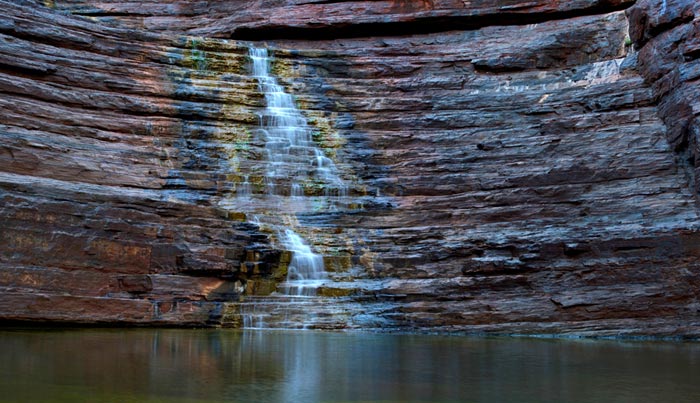
© 2012 Barry Epstein. All Rights Reserved.
Joffre Falls
Canon 7D, 5 photos 50 mm lens, f22, 1/10 sec, ISO 100
I was holding my camera over my head as I walked through the freezing water that quickly deepened and was now up to my shoulders.After only a few more steps, the water was at my chin and I became quite anxious, as swimming with my heavy camera gear could be an issue, even if it and my warm and dry clothes were safely encased in a waterproof knapsack. I had to strip down to my bathers earlier, but I kept my sneakers and socks on to walk through this 80-foot narrow water passage.
About an hour before my hike commenced, I awoke to frost on the tent and now I was deep down in the Hancock Gorge, in the shade and in the water. It was both cold and invigorating. Fortunately, I was now near the shallow end of the streambed that I was walking through and I did not have to swim or tread water.
The next part of the trail proved to be challenging as I spider walked with both hands and feet through another narrow part of the stream and then over very slippery rocks. The effort paid off as I entered into a magnificent cavern known as Kermit’s Pool, where I started making some photographs. The lighting was perfect. The wind was whipping through this underground chamber, but for some reason, I didn’t feel the cold anymore.
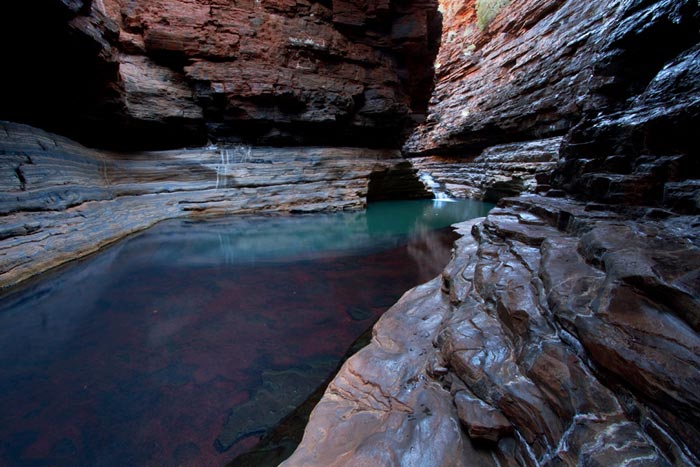
© 2012 Barry Epstein. All Rights Reserved.
Kermit Pool in the Hancock Gorge
Canon 7D, 10 mm lens (10-22), f14, 1/25 sec, ISO 100
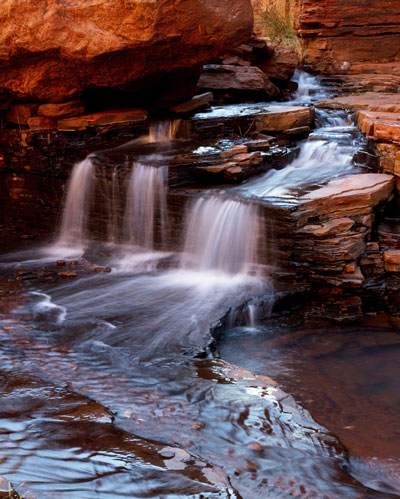
© 2012 Barry Epstein. All rights reserved.
The well-marked trail had started at a relatively easy Class 2, and after descending down into the gorge that included two very steep and long ladders, the degree of difficulty increased dramatically to Class 4. Where I had just walked was a Class 5, representing the most difficult without specialized climbing equipment. At the end of Kermit’s Pool was a clearly marked warning sign at the top of a waterfall that took qualified rock climbers deeper into the gorge. From here I could see another spectacular cavern down below. The return hike allowed me to photograph a small waterfall and I ran into several other hikers, many with their cameras, who were not prepared to walk through the deeper water to get to see the true highlights of the trail.
Photo: Stream Inside a Gorge
Canon 7D, 4 photos, 50 mm lens, f22, 1/4 sec, ISO 100
I was in the beautiful Karijini National Park, located 1,400 kilometers (900 miles) north of Perth Western Australia in the Pilbara region. Iron rich rock formations in many gorges have been carved out for more than 2,500 million years. The numerous hiking trails allow adventurers to see first hand the spectacular pools, waterfalls, steep cliffs, caverns and the polished tiered banded layers of rock. Recommended travel times are during the dry season, between April and October.
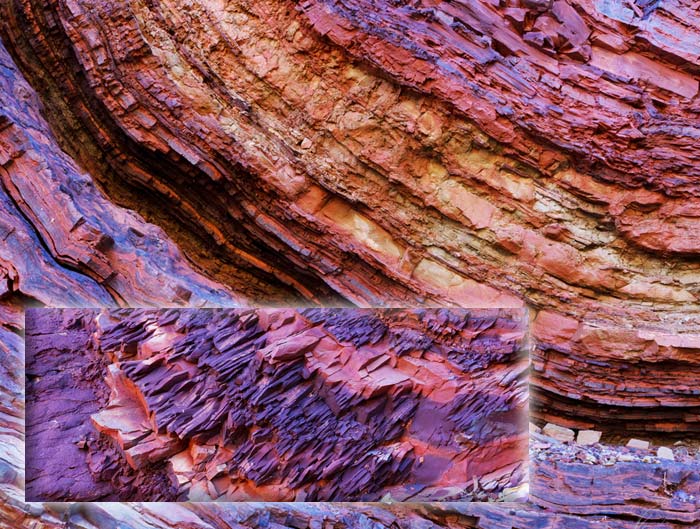
© 2012 Barry Epstein. All Rights Reserved.
Rock Layers & Close-up of Shale Rock
Canon 7D, 4 photos, 50 mm lens, f22, 1/10 sec, ISO 100
I stayed at the Eco Tourism Western Australia, award-winning Karijini Eco Retreat for 6 nights. It is centrally located and well organized with an equipped-up market facility, including an alfresco and fully licensed restaurant. The staff is extremely friendly and hiking savvy. I used my own tent, however there are eco tents available for use at varying prices. There was a small fee to charge my camera battery and laptop and there was limited Internet access. I noticed the presence of many young couples and elderly groups who were eager to share their experiences.
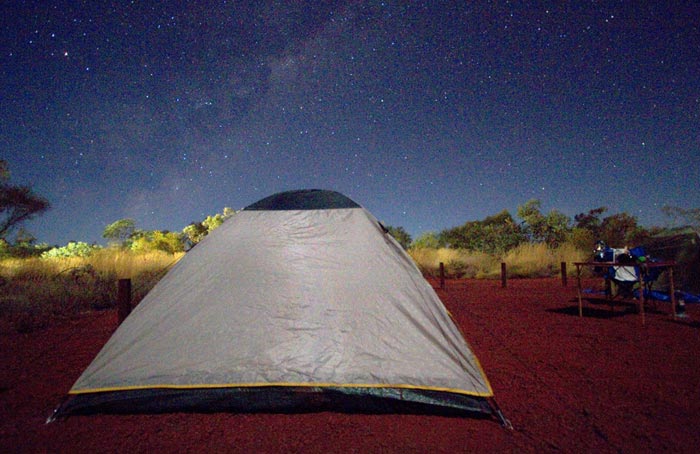
© 2012 Barry Epstein. All Rights Reserved.
Tent and Night Sky at Karijini EcoRetreat
Canon 7D, 10mm lens (10-22), f3.5, 25 sec, ISO 6400
After a few hours hiking, I ascended the Hancock Gorge, had a bite to eat and started another nearby trail for the Weano Gorge. The sun was out and the weather had warmed up, so I hiked in shorts and a short sleeve shirt until I had to strip down again to my bathers. There were similar rock pools to negotiate that ended in another Class 5 level area known as Handrail Pool. I had to straddle the handrail and vertically descend to the bottom of this beautiful cavern that allowed qualified rock climbers to continue deeper.
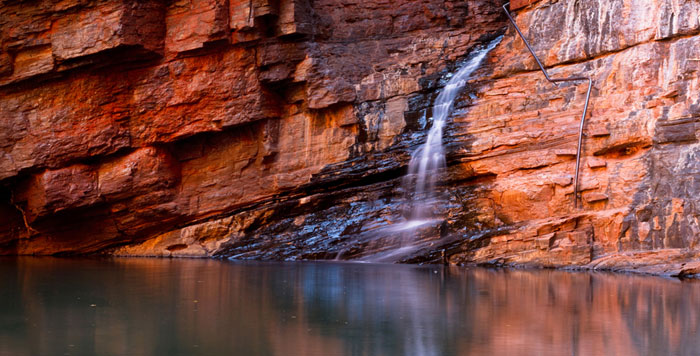
© 2012 Barry Epstein. All Rights Reserved.
Handrail Pool in the Weano Gorge
Canon 7D, 2 photos, 50 mm lens, f22, 1/25 sec, ISO 100
The easy Class 3 hike to Dales Gorge in the late afternoon the following day allowed photographs of the Fortescue Falls to be taken in the shade.
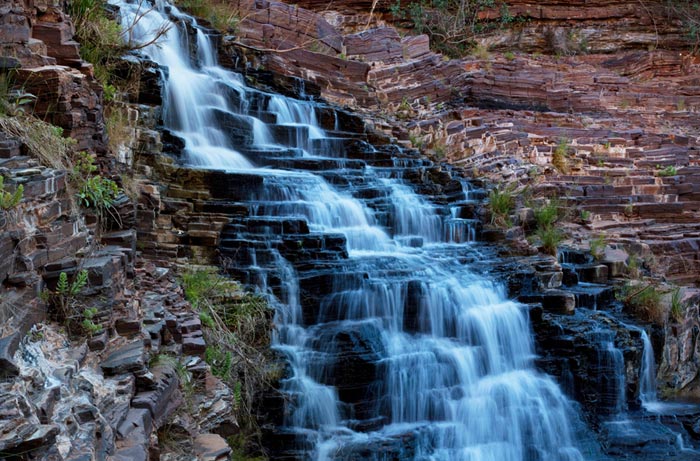
© 2012 Barry Epstein. All Rights Reserved.
Fortescue Falls in the Dales Gorge
Canon 7D, 4 photos, 50 mm lens, f14, 1/8 sec, ISO 100
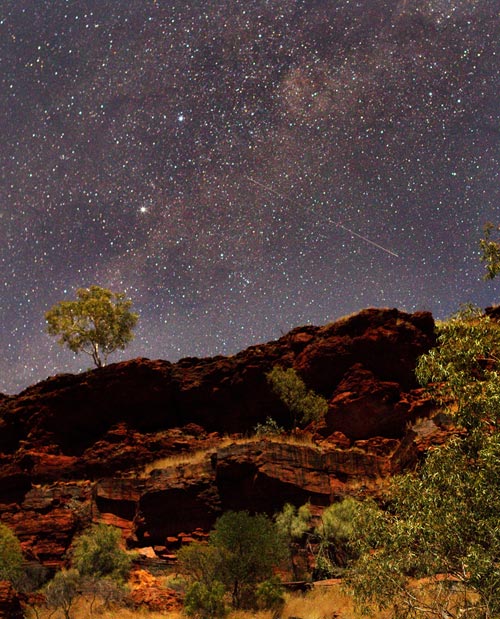
© 2012 Barry Epstein. All rights reserved.
I decided to then wait until night to try and capture the stars. As I watched the skies and the sun was setting, a seemingly endless number of Ghost Bats, with wingspans of 50 cm (1.5 feet), emerged from the caves and flew quite close. The stars came out, although the moon was quite bright, and I was able to shoot a vertical panorama of Dales Gorge that captured a shooting star or satellite.
Walking up from the bottom of this gorge was fun in the moonlight and the use of a small flashlight was necessary. On two evenings, I could hear the dingo’s running close by the tent and it was interesting to listen to them howl.
Dales Gorge Night Sky
Canon 7D, 3 photos, 50 mm lens, f1.4, 25 sec, ISO
On another morning I hiked into the Joffre Gorge (lead photo above). The trail started at my campsite, and although it began as an easy Class 2, it quickly advanced to a Class 5. It was fearfully steep climbing, which proved difficult with my large camera backpack. It was necessary on several occasions to remove my backpack and carefully pass it to my hiking companion. Once again, my efforts were quickly rewarded as the Joffre Falls appeared around the corner from a narrow part of the path. Being first in the gorge early in the morning provided the best lighting, however, I wish that I had arrived a bit earlier, as the sky above the falls was too bright.
There were many posted notices about snakebite treatment. I understood that there were some small, but extremely venomous snakes with ominous names like Death Adder and Tiger. In addition to those were some very large, non-venomous snakes like the Olive Python that are more than 4 meters (13 feet) in length. This information had gone through my mind several times as I reached into every crevice I could to find my grip in the many steep climbs.
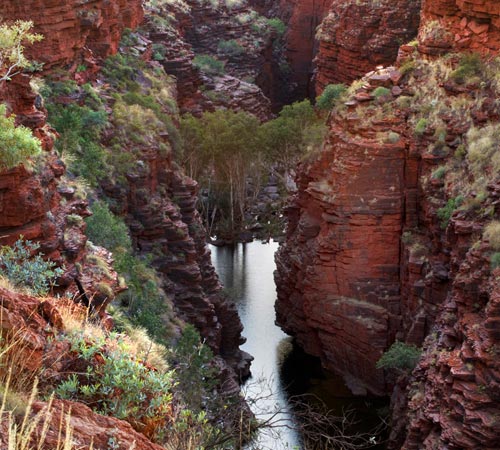
© 2012 Barry Epstein. All Rights Reserved.
Be sure to visit Knox Gorge while you’re there.
Canon 7D, 3 photos, 70 mm lens (70-200), f18, 1/10 sec, ISO 100
Adventurers can reach Karijini National Park by car and it is a 16-hour trip from Perth, Western Australia. During the drive, you’ll pass through some quaint and incredibly small outback towns (Cue and Mount Magnet). Preparation for such a trip included a song playlist of 240 songs that lasted for the one-way drive and a 13-hour audio book. It is critical to bring extra tires, as travel in the park is on gravel roads. Distances between the gorge’s are far and the rocks are sharp and tend to shred tires. The car I was in had one flat tire that required traveling 2 hours to the nearest town for repair. The following day, another tire was shredded and had to be replaced. Also, it is recommended to bring plenty of extra petrol (gas), as the nearest station is over 2 hours away.
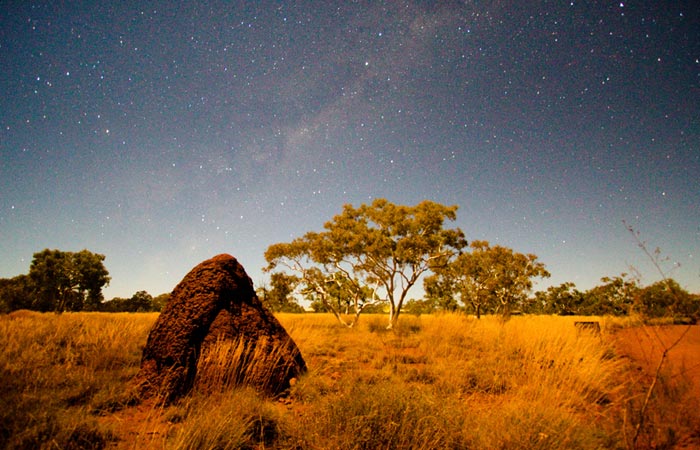
© 2012 Barry Epstein. All Rights Reserved.
Termite Mound and Night Sky
Canon 7D, 10 mm lens, f3.5, 15 sec, ISO 6400
Visitors can fly (Qantas) into one of the relatively nearby towns (Paraburdoo, Newman, Karratha or Port Hedland) and hire a vehicle.
If you are in search of a real outback-Australian bush walking adventure, are fit and healthy and have waterproof gear for your camera, Karijini National Park could be just the place for you.
by Barry Epstein

Leave a Reply